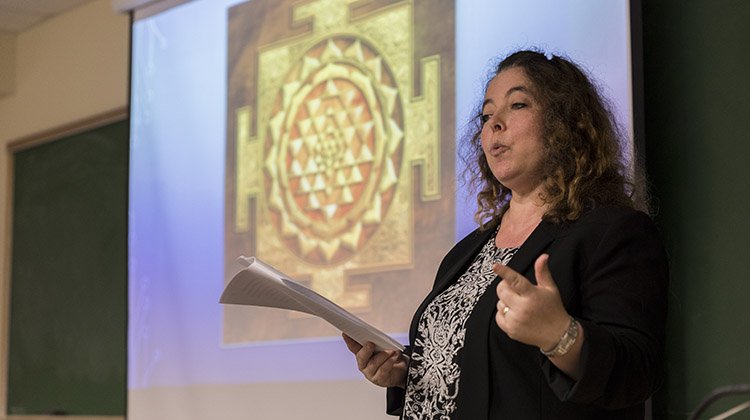Gawande Speaker Series examines the role of robots in ancient Indian tales

Professor Signe Cohen presents “I, Robot: Self and No-Self in Ancient Indian Android Tales” as part of Ohio University’s Gawande Speaker Series in Indian Religion and Philosophy. Photo by Max Catalano
Modern day, it is common for robots, indistinguishable from human beings, to make appearances in science fiction movies, books or television shows. However, one professor’s research has focused on the role of robots, androids and artificially constructed humans in ancient tales from across the world.
Signe Cohen, associate professor and chair of religious studies at the University of Missouri, recently presented “I, Robot: Self and No-Self in Ancient Indian Android Tales” at Ohio University. The Sept. 27 lecture was sponsored by the Friends of India Endowment and Gawande Speaker Series in Indian Religion and Philosophy.
Cohen, who is the first researcher to systematically study ancient robot tales, explained that when robots are referenced in ancient stories, they are often “fragments and brief interludes in texts dealing with a variety of other topics rather than a cohesive collection of stories.” The fleeting references are embedded in various genres within South Asian texts, including fairytales, didactic literature and even a religious tale that recounts the past lives of the Buddha.
During her introduction, Cohen posed a question that turned into an overarching theme throughout the lecture.
“If we can imagine a moving, talking machine, constructed in the likeness of a human being, then what makes someone human as opposed to a robot?” she asked.
In an effort to answer her own question, Cohen suggested a variety of traditionally human characteristics. Is it our flesh that makes us human? Or is it our DNA, language, consciousness, self-awareness or ability to feel empathy for others?
The answer, of course, isn’t so simple. Cohen’s lecture explored a multitude of ancient Indian stories, and the mechanical beings that can play a variety of roles within them. In some stories, robots are seen as an entertaining blessing, while in others, they are looked down upon.
“…These mechanical beings of literature, television or film embody fundamental cultural anxieties about what it means to be human,” Cohen explained.
Instances of machines coming alive are not just found in ancient stories. In September 1995, the “Hindu Milk Miracle” received national attention. According to Cohen, it was rumored that statues of the Hindu deity, Ganesha, were drinking milk offerings left by Hindu worshippers.
A video surfaced of milk vanishing from a spoon once it was held up to a statue. This resulted in milk sales skyrocketing all over India. Scientists quickly came forward with a rational explanation—capillary action, which is the ability of liquid to flow into narrow spaces.
“Whatever the explanation may be, the so-called Milk Miracle attests to the widespread idea that the mūrti (statue) can, in some cases, have agency and can effect a change in the consumer world,” Cohen said.
More than 30 individuals, including students, faculty and members of the Friends of India Endowment’s Board of Trustees members, attended Cohen’s lecture.
Elizabeth Sekeres, BSH ’19, attended the lecture, noting thata class she took at Ohio University piqued her interest in world religions.
“It was interesting to hear Professor Cohen talk about the role of machines and robots in the ancient world,” Sekeres said. “I never realized that those things were documented in books and stories so long ago.”
